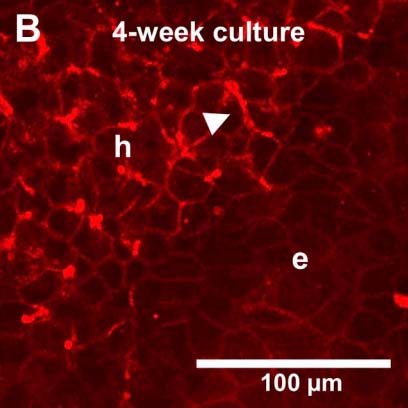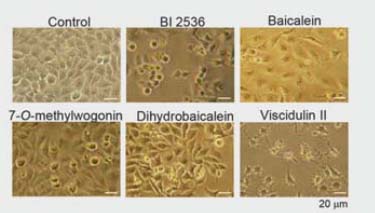- In-Stock Tumor Cell Lines
- Human Orbital Fibroblasts
- Human Microglia
- Human Pulmonary Alveolar Epithelial Cells
- Human Colonic Fibroblasts
- Human Type II Alveolar Epithelial Cells
- Human Valvular Interstitial Cells
- Human Thyroid Epithelial Cells
- C57BL/6 Mouse Dermal Fibroblasts
- Human Alveolar Macrophages
- Human Dermal Fibroblasts, Adult
- Human Lung Fibroblasts, Adult
- Human Retinal Muller Cells
- Human Articular Chondrocytes
- Human Retinal Pigment Epithelial Cells
- Human Pancreatic Islets of Langerhans Cells
- Human Kidney Podocyte Cells
- Human Renal Proximal Tubule Cells
Abstract
Hepatocellular carcinoma (HCC) is one of the lethal cancers with a dramatically rising incidence rate. HCC cell lines are widely used in various types of liver cancer research. Genomes of hepatocellular carcinoma cell lines are different from those of healthy human cells. Common homo sapiens hepatocellular cancer cell lines include PLC, Huh7, Huh7.5, Hep3B, HepG2, SMMC-7721, MHCC97-H, MHCC9-L and so on; and each cell line has its own characteristics. Therefore, the genome and hepatotoxicity of hepatocellular carcinoma cell lines are very significative in researching the occurrence and development of hepatocellular carcinoma.
Product background
The hepatocellular carcinoma cell line is a cell group formed by the continuous division and proliferation of a single cell after isolation from the pathological tissues of hepatocellular carcinoma. It has the characteristics very similar to the original tissues and the complete genetic material of the human body and can be passed on steadily. Human hepatocellular carcinoma cell lines have different names because of the parental patients from which they were isolated. The common hepatocellular carcinoma cell lines are PLC, Huh7, Huh7.5, Hep3B, HepG2, SMMC-7721, MHCC97-H, MHCC9-L and so on; and these hepatocellular carcinoma cell lines have been studied in the aspects of etiology, pathogenesis, diagnosis, treatment, drug screening, animal experiments and so on. Hepatocellular carcinoma (HCC) cell lines are widely used. Because they have similar characteristics to original HCC cells, i.e. no biological changes, stable characteristics, and unlimited passage, they provide an ideal situation in vitro model for the study of HCC and become another favorite replacement in the study of HCC diseases except conducting animal experiments. The characteristics of several human hepatocellular carcinoma cell lines and their latest research were collated to provide a reference for oncologists’ experimental research. So, they are suitable for hepatocellular carcinoma research.
The Latest Research
-
1. The Genomic Characteristics of Human Hepatoma Cell line Huh7 were Very Susceptible to The Number of Passages, and Differentiated Huh7 Cells may be Suitable for Researching the Functions of The Liver Hepatotoxicity with The Protein Expression of Drug Metabolizing Enzymes.
application: Huh-7 cell lines commonly used to conduct research on the pathogenesis of hepatocellular carcinoma and it may represent a convenient and affordable alternative to the use of human hepatocytes.
Hidekazu et al. isolated and cultured Huh 7 from tissues of well-differentiated hepatocellular carcinoma patients in 1982[1], but the genetic map of the hepatocellular cancer cell was not known to the public. Fumio Kasai et al. performed M-Fish, SNP microarray sequences, and sequence analysis on the Huh 7 hepatocellular carcinoma cell line to identify its maps, and they found high-level LOH could increase the probability of chromosomal rearrangement and Huh7 hepatocellular carcinoma cell was highly susceptible to genetic variations during culturing, also, different generations may have different patterns between in vitro experiments[2]. Malinen et al. found that long-differentiated Huh-7 cell lines are a promising in vitro model of hepatotoxic and endogenous compounds for the detection of drugs[3](Figure 1). Jouan et al. found that HuH-7 cells up-regulated some of the transporters associated with farnesol X receptor (FXR) and nuclear factor erythrocyte 2-related factor 2 (Nrf2). These data suggest while expressing some of the major liver drug transporters, so it may be used to study drug interactions with MRP.[4]


Figure 1. The Cultivating morphology of representative Huh7 cells can last for 7 days (A) or 28 days (B), where the Huh7 cells appeared as a homogeneous cell population with an epithelial phenotype showing no regular structural organization. After the cells reached confluency, they underwent morphological changes and took on the appearance of cuboidal cells, hepatocyte-like cells, and spherical actin filament bundles. After 4 weeks of culturing, the cells had organized into two different clusters[3].
-
2. The Mutation History of HepG2 and The Oncogene Regulation Complexity of The Database were Provided to Elucidate the Genomic Sequence and Genomic Structure of The HepG2 Hepatoma Cell Line Accurately, meanwhile Toxicity Studies will Clarify the Pathogenesis of Liver Cancer.
application: HepG2 human hepatocellular carcinoma cell line has been widely used in the physiological study of the liver, but the expression levels of liver-specific drug-metabolizing enzymes and transcription factors are low.
The results of the genome and epigenome-related literature for the HepG2 cell line are statistically shown to be insufficient to demonstrate the genomic sequence and create higher genomic characteristics of the HepG2 hepatocellular carcinoma cell line. Zhou et al. fully integrated the genome-wide features and gene sequences of the HepG2 cell line including CN, SNPS, SNV and so on; their research also laid the foundation for complete genome identification of other similar cell lines [5]. Juliana et al. found that β-myrcene is more cytotoxic to human leukocytes than human HepG2/C3A hepatocellular carcinoma cells. However, monoterpene has higher hepatotoxicity than HepG2/C3A cell, which is superior to white blood cells. In vivo studies demonstrating carcinogenic and teratogenic effects associated with β-myrcene require further experimental confirmation[6]. Arunraj et al. found that the composite nanogel is cytotoxic to the HepG2 cell line, and the Dox-chitin-PLA CNG system may be a promising anticancer drug delivery system for liver cancer[7, 8].
-
3. The cDNA Library of Hep3B Hepatoma Cells and The Toxicity Study on Hep3B Hepatoma Cells were Explained, which would Help Us Better Understand Hepatocellular Carcinoma and Select The Best Cell Line for Cell Experiments.
application: The human hepatoma Hep3B cell line has long been used to test the efficacy of therapeutic agents, vitro cytotoxicity, DNA synthesis, and caspase activity.
-
Xie et al. found that cDNA arrays are powerful tools for exploring gene expression profiles and their results laid the foundation for elucidating the study of gene growth and apoptosis in Hep-3B and other cells.[9]Yu et al. developed a miniature three-dimensional cell culture array to research the effects of different compounds for the three-dimensional culture of the Hep3B cell line. They found that the Hep3B cell line is more resistant to certain drugs than the HepG2 cell line, this research may provide rapid and inexpensive metabolically induced toxicity assessment in the early stages of drug development[10, 11].

Figure 2. Hep3B cellular morphology observed after treatment of the cells with BI 2536, a specific Plk1 inhi -bitor[12]
Conclusion
Human hepatocarcinoma cells are mostly derived cells from primary liver cancer tissues. By culturing hepatocellular carcinoma cells and analyzing them at a single-cell level, it is possible to understand the subtleties of the formation of hepatocellular carcinoma in more detail and apply them to the study of hepatocellular carcinoma biology. One advantage of using in vitro systems for research is that they can be done faster and cheaper than in vivo studies. For example, if you want to do experiments on the proliferation of hepatocellular carcinoma cells, you can choose HepG2 or Hep3B hepatocellular carcinoma cells instead of spending too much time choosing them. The genome and cytotoxicity of HepG2, Huh7, and Hep3B have been researched deeply, as they are essential for the development of hepatocellular carcinoma diseases and drug development in the later stage.
AcceGen Hepatocellular Carcinoma Cell Lines
AcceGen provides high-quality hepatocellular carcinoma cell lines
For more information, please contact us at 1-862-686-2696, or email us at [email protected].

Copyright - Unless otherwise stated all contents of this website are AcceGen™ All Rights Reserved – Full details of the use of materials on this site please refer to AcceGen Editorial Policy – Guest Posts are welcome, by submitting a guest post to AcceGen you are agree to the AcceGen Guest Post Agreement – Any concerns please contact [email protected]








